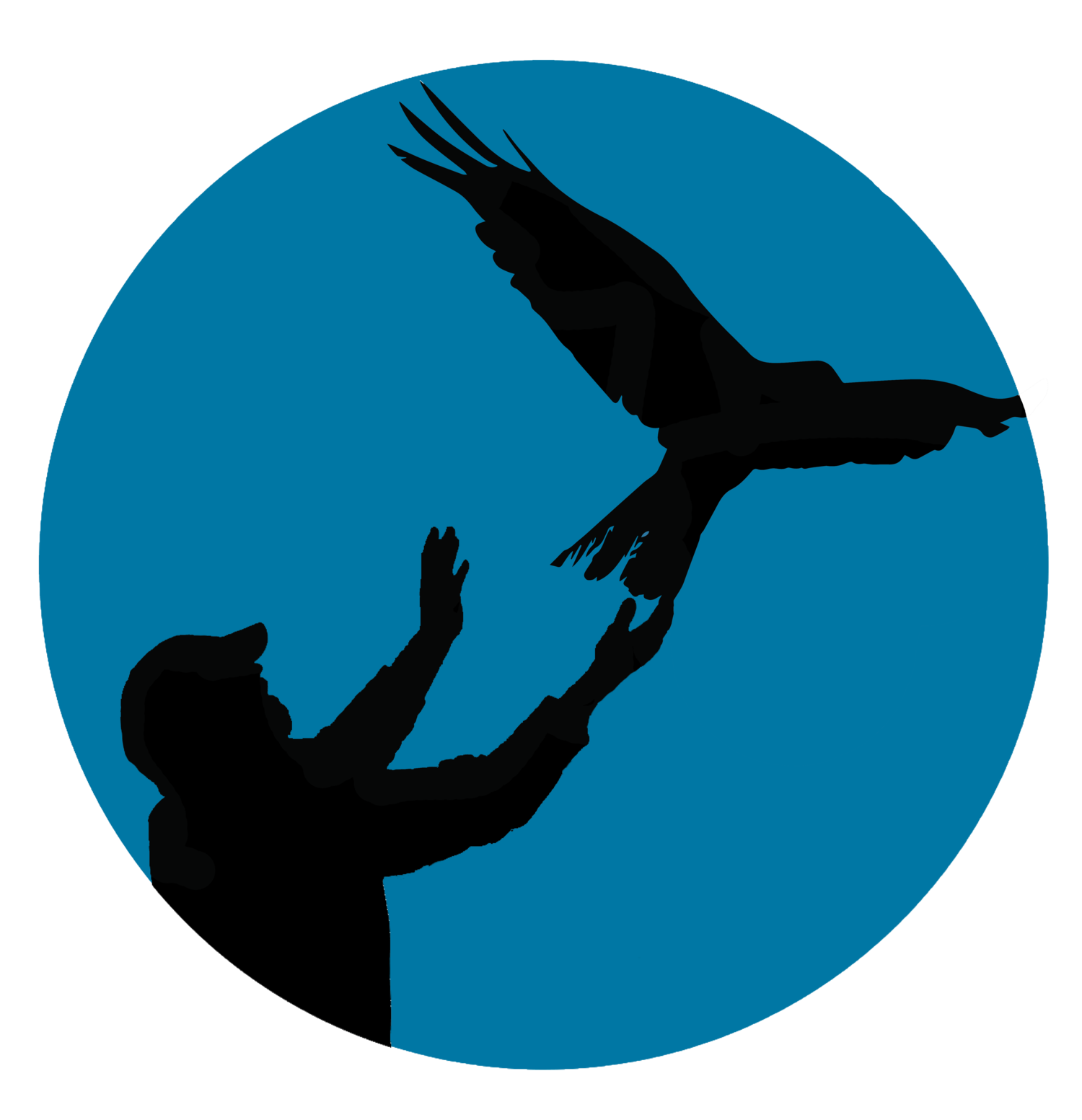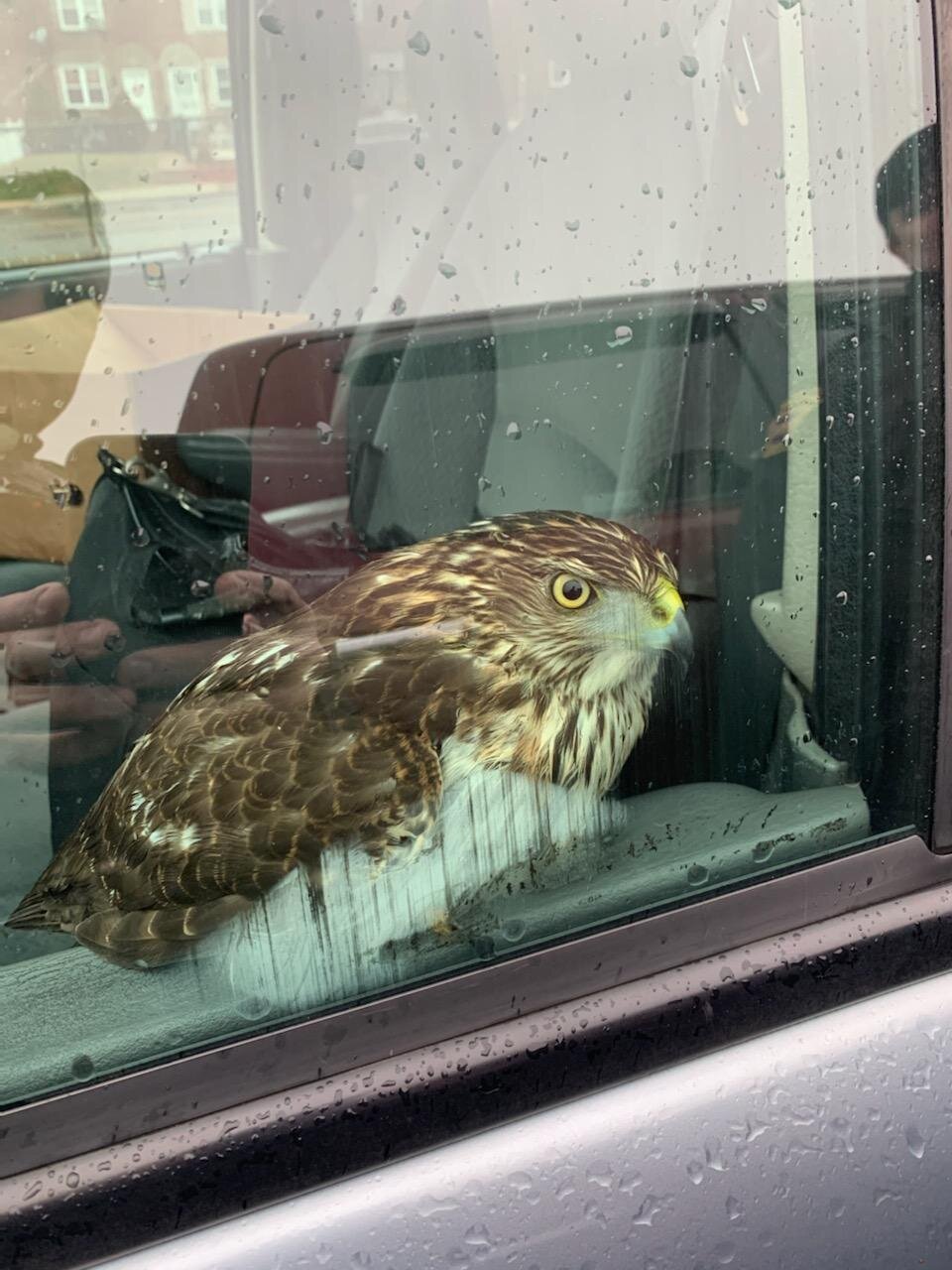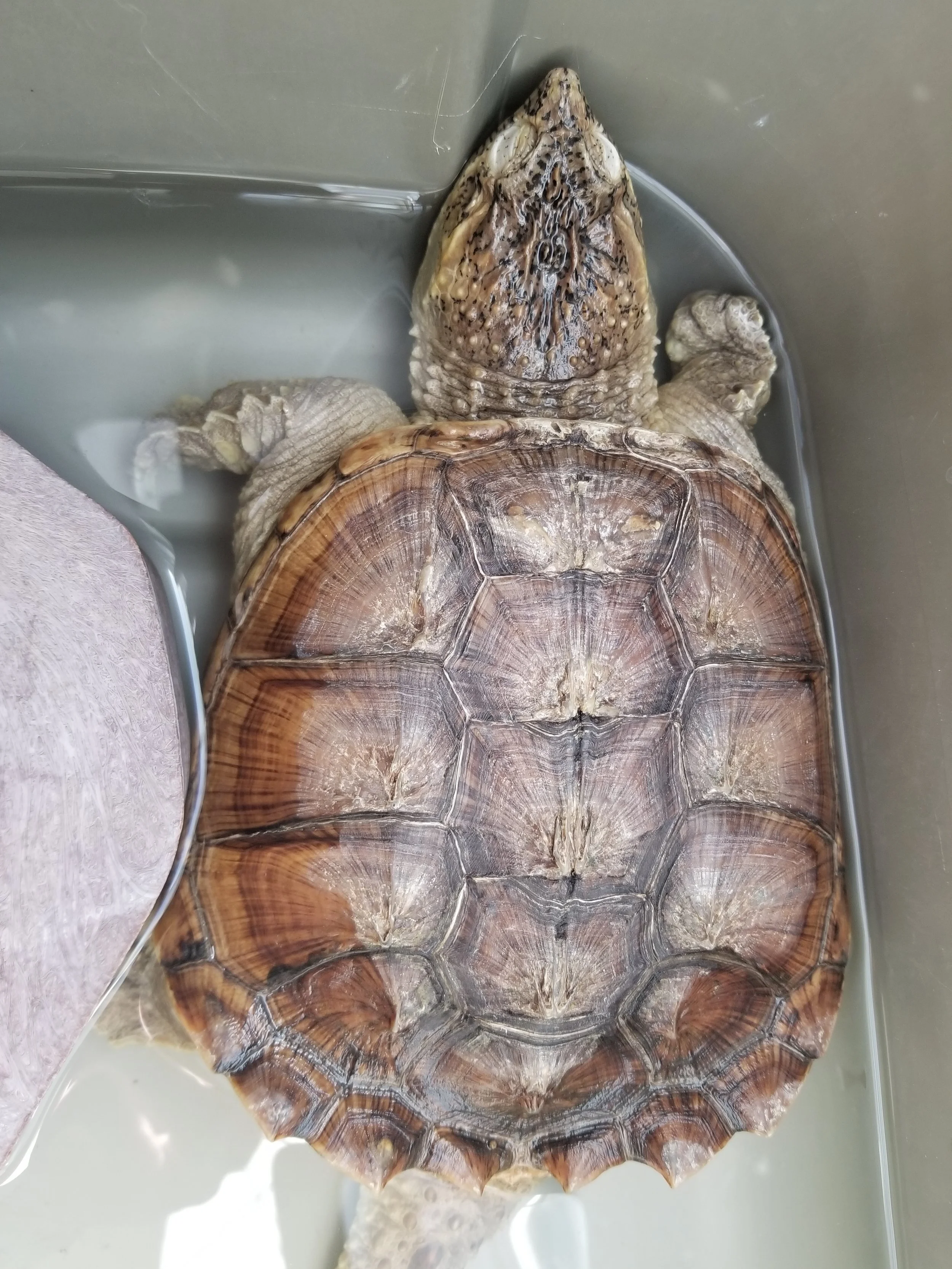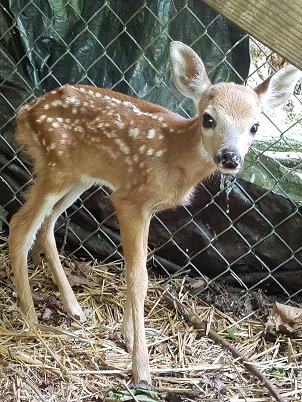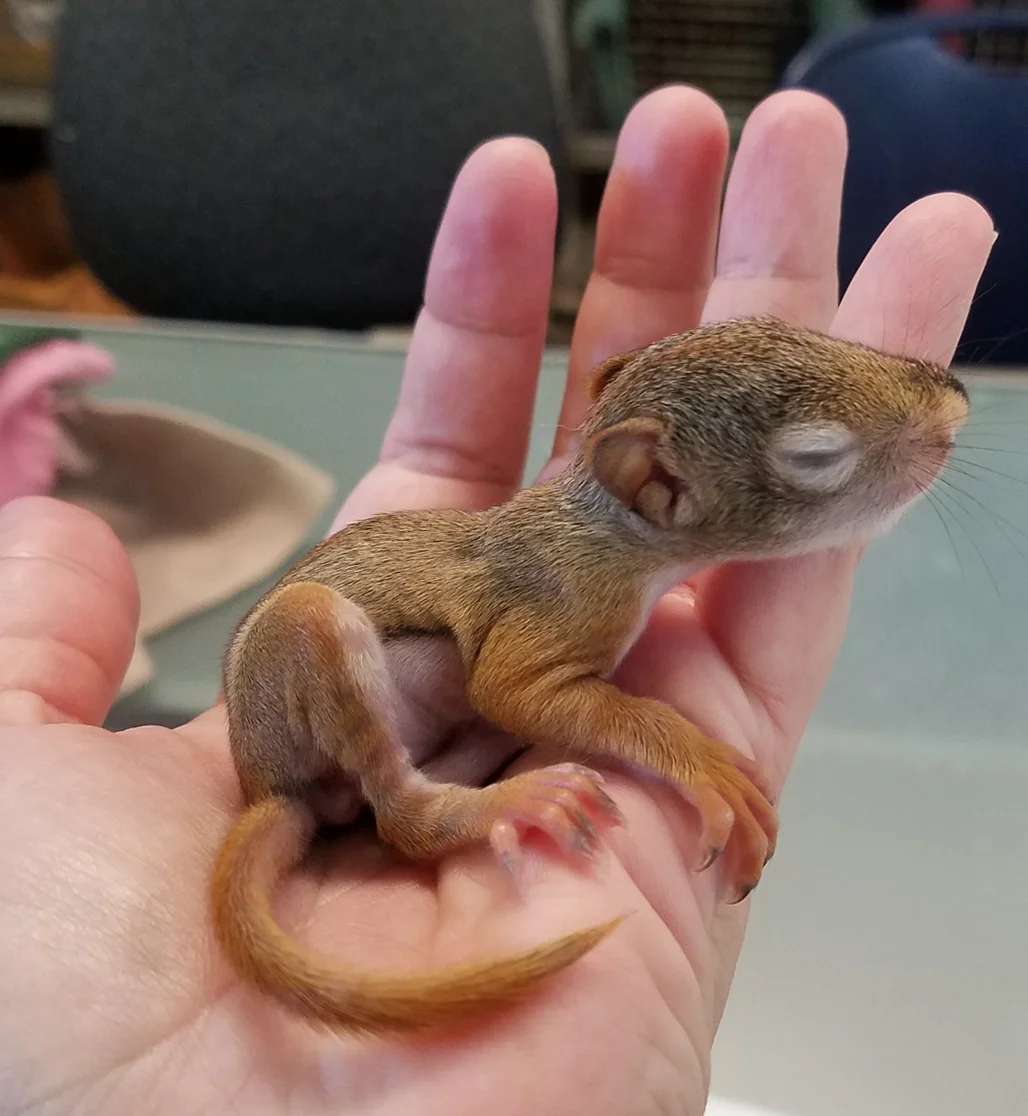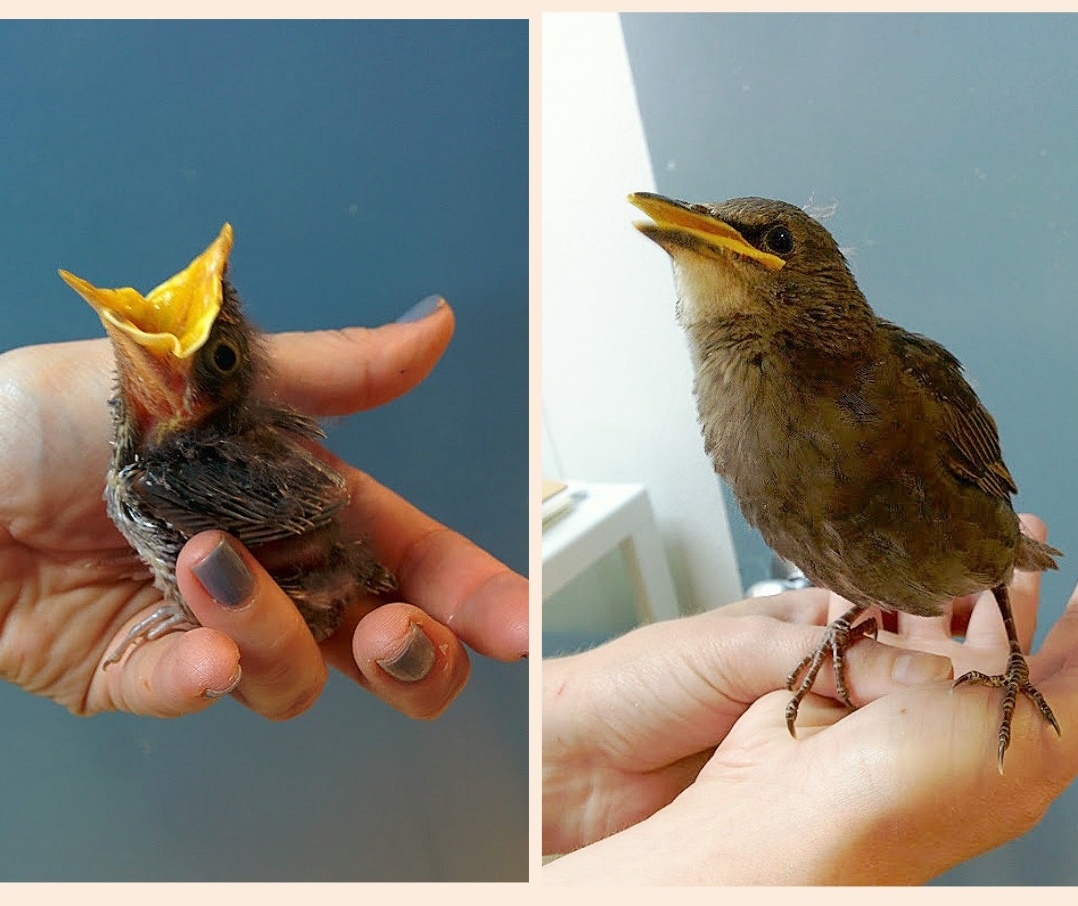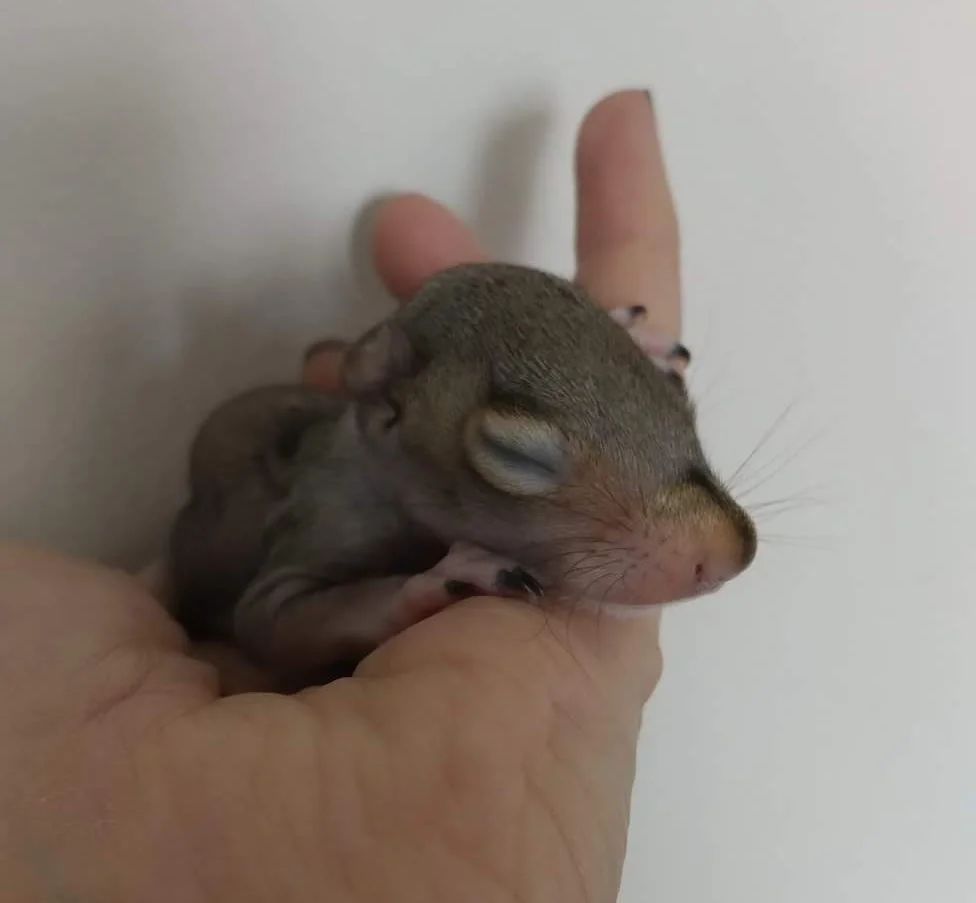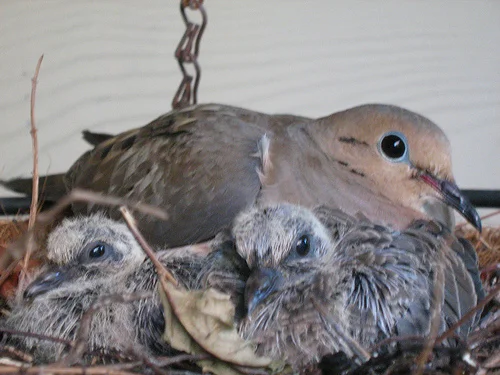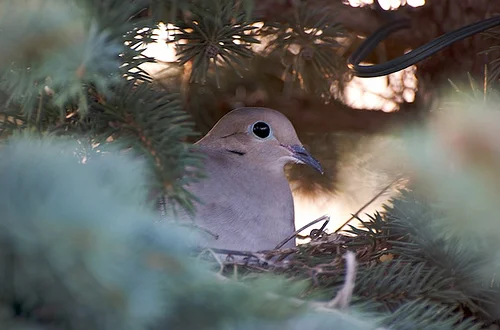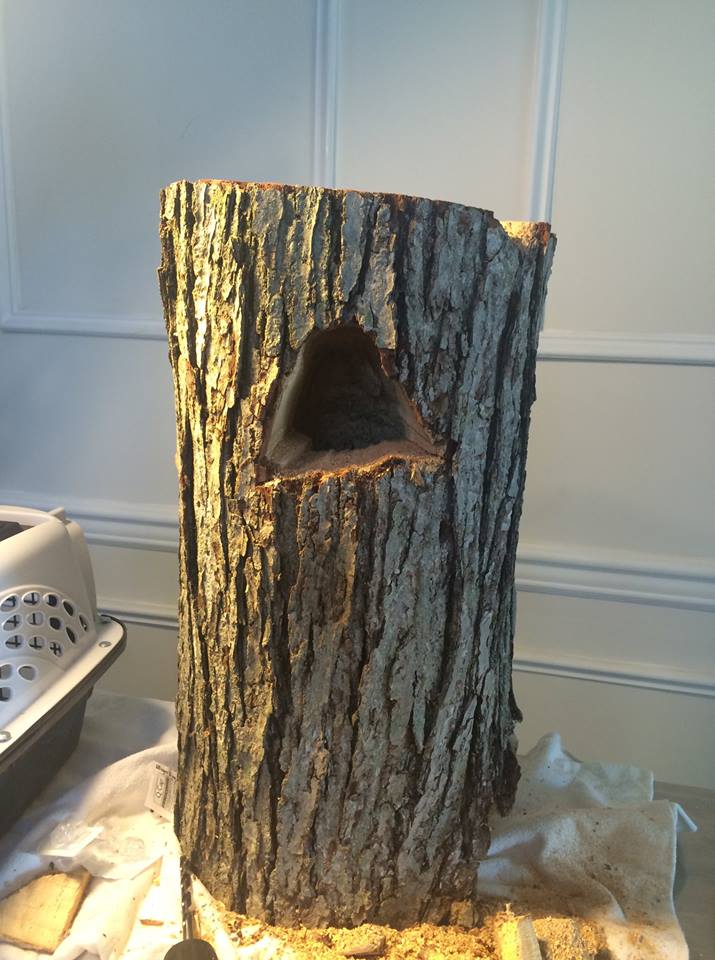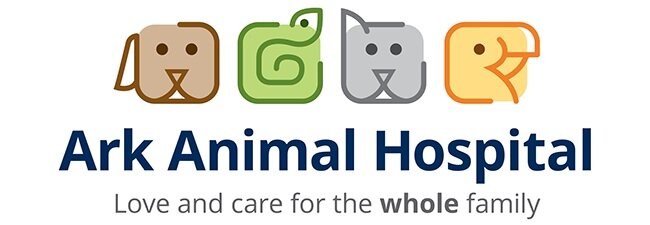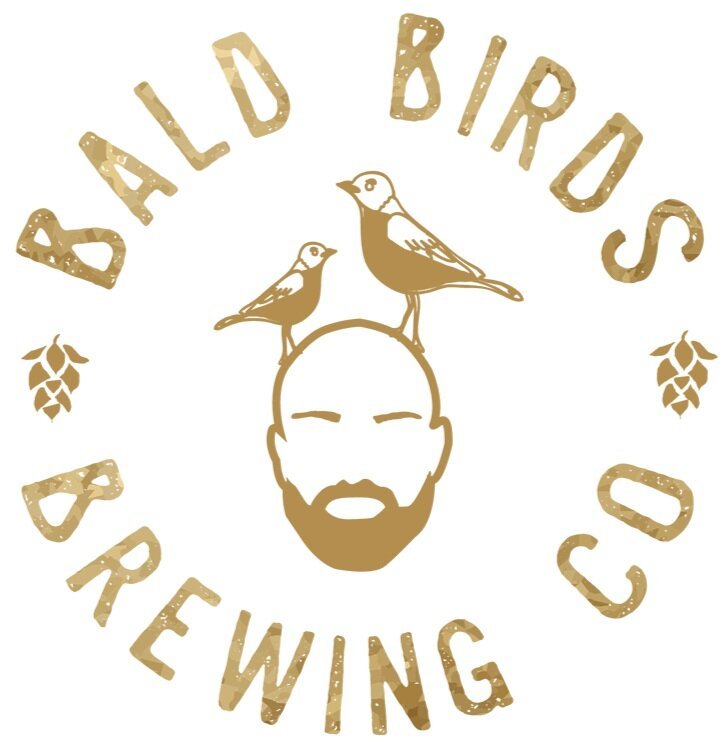An old tradition with our long established team is our “First baby squirrel of the year” competition. Our volunteers and staff compete to guess the date of the arrival of this season’s first baby squirrel, and write their guess on a whiteboard. It’s not as easy as you think! Squirrels start giving birth in February but a number of factors may impact when the first one comes into care. The prestigious “no prize” goes to the winner. This year’s co-winners were Lisa, our business manager, and Shannon, a long time volunteer, who chose February 22nd. This group of newborns was brought when someone cut down the tree which housed their nest. Often, we can reunite babies and their mother but it couldn’t happen in this case. If you are doing tree work, please check for nests in the branches and inside the tree first. If you accidentally cut down a tree that houses baby animals of any kind, please call us! Reuniting mom and babies is our first priority and we’ll happy to advise you what to do.
Fingers crossed for a turkey vulture
We are hoping for recovery for this turkey vulture, who was clipped by a car, and is not flying. She seems to have a tiny bit of weakness in the tip of her right wing, but xrays revealed no broken bones. We are also awaiting the results of a lead level blood test on this bird. Lead poisoning is absolutely epidemic in large birds, with bald eagles, vultures and geese being the most usual victims. The cause of this is lead ammunition, which both gets in the water, and is also left in fragments of deer carcass “gut piles” by hunters, which is eaten by eagles and other birds of prey. Lead toxicity causes weakness and disorientation in these birds, and if the lead doesn’t kill them, the lack of coordination caused by lead poisoning can lead to them being hit by cars. We are hoping that our turkey vulture here does not have a high lead level. If caught early, sometimes treatment can work. But so many raptors and waterfowl are never found, and perish from this poisoning. You can help! If you are a hunter, consider switching to non-lead ammunition. Information can be found here. If there is a hunter in your life, please pass on this life saving info that, if enough people complied, could save thousands of Pennsylvania birds. If you’re a hunter, can it start with you?
The Red Tail's new clothes
Great news for this Red Tailed Hawk, who was given some brand new feathers at our of his center this week. Yesterday, he tried them out for the first time. We test flew him on a ‘creance” which is like a long fishing line.
And he flew.
This hawk has had a tough time. He was hit by a car, and in addition to the injuries he sustained to his body, many of his important feathers were badly damaged, including his tail (his steering and brakes!) and some primary flight feathers on his wings (what gives him the ‘lift’ he needs to fly).
At PMWC we performed an implant procedure called “imping” (short for implanting) where we took feathers from a deceased bird of the same species and sex, and gave them to the live bird.
By doing this, we can release the patient earlier, and he won’t have to spend months in a cage waiting for the feathers to grow back. (And, when his body is ready to grow new feathers, he will molt these out as though they were his own)
So yesterday, he flew in brand new feathers! And, the feathers of the bird who didn’t make it will once again be in the sky, helping our patient get back to his wild life. After about a week of flight conditioning, he should be ready to go.
Itchy Business
Good news for raccoon #0028. He’s a long term patient we are treating for sarcoptic mange. He’s looking brighter and his appetite has improved since he’s been in treatment. If you are concerned about an animal who has mange, please give us a call. There are several options for ways to help an animal with this condition. Mange is common in foxes and raccoons, but other animals can get it too. Observable symptoms include loss of fur, seeing the animal scratching, and wounds on the body (from the incessant scratching). The good news is that it responds well to treatment, giving the animal relief from a very cruel infection. If you see an animal you think has the condition, we are happy to advise.
Hawk hit by car saved - thanks!
Thanks to a quick thinking member of the public and to the Upper Darby Police who called us to arrange help for this hawk who was clipped by car. He escaped the box he was captured in and spent some time in a vehicle, looking out the window..but we were happy to answer the call.
January 25, 2020 GOLDFINCH #2376 RELEASED
Goodbye, Goldfinch #2376. We will soon be releasing this Goldfinch back to where it was found. We release all adult animals back to their own territory. The Goldfinch was successfully treated for conjunctivitis, an eye infection to which finches are particularly susceptible. This bird 's treatment required antibiotic eye ointment, as well as 21 days of oral antibiotic to ensure the bird was free from infection and not a carrier. Although the bird probably didn't enjoy such a long captivity, this ensures freedom from disease before release. Good luck finch!
Amphibians and Reptiles at the PWMC
By Rick Schubert, Director
Reptiles in Rehab
Lots of reptiles and amphibians here right now. They need help too, and equal care to birds and mammals. Garter snake with a wound on his side, red eared sliders with shell rot, snapping turtle with a deformed shell from being kept as a pet, eastern box turtle missing a leg, American toad found in the snow, a little too early to be out of hibernation. "Toadbert" is really cool and we hope to get him back out real soon.
We also have a three-toed box turtle that was also found out in the snow. They're not native box turtles to PA, and are often kept as pets to circumvent the (very wise) laws against keeping native box turtles (because their numbers in the wild are plummeting). But someone probably got tired of him and thought dumping him in the woods was an option. That's not okay---because they're not from around here and can't hibernate properly and will die. Keeping any pet is a lifetime commitment, but we strongly recommend against keeping any kind of wild animal, even legal ones. They aren't interactive and don't want to be with you. They deserve to be free! Adopt a dog or cat instead.
An important note about our center: we and many other wildlife centers are not normally able to take non-native turtles except in extreme cases where immediate humane aid might be called for, and no other help is available. As we are a wildlife rehabilitation center, we do not have the resources to deal with pets. There are pet reptile rescues that can help in those situations. In the case of the current exceptions that we wound up with, they will not be released into the wild because that would not be ecologically prudent. Rather, we will find appropriate homes for them. This has to be done very slowly and carefully, so that they do not wind up discarded back into the wild again. This is why we strongly discourage buying these animals as pets. As far as native reptiles, NEVER take them from the wild to keep as pets!
Baby Fox Rehabilitation Considerations
By Rick Schubert, Director
Last week we received our first baby Red Fox of the year (above) Before the Ooo's and Ahhh's commence, there are some important things to say about this:
First, it is only as a last resort that wildlife rehabbers take animals like this into human care. Most of the work we do is over the phone, and out of every call we receive about a possibly orphaned animal, we only need to admit about a quarter of them to the Center. The rest either just need to be left alone, or we can talk you through reuniting them with the parents. That's why experience is so critical in a wildlife rehabber.
Second, the red fox is a Rabies-vector Species in Pennsylvania, along with raccoons, woodchucks, skunks, coyotes, and bats. It is beyond critical that these animals are not handled with bare hands. Any mistakes here means a death sentence for the animal. Fay, the volunteer feeding the fox here, is vaccinated against rabies and has been volunteering for us for 13 years.
Third, this is a lone single fox...we eventually have to get it with others. The cardinal sin of wildlife rehabilitation is to rehab any animal in such a way that it becomes tame. To do that is a gross breach of our ethics, and will result in the death of the animal. It MUST be raised with others of its own kind, it MUST have absolutely minimal handling, and upon release (in this case, at about six months old), it MUST be 100% able to survive on its own. Teaching baby foxes to be foxes is not an easy task, especially because it must be done without them seeing humans. But, that's why we're here. We respect their wildness, we respect their free will.
Ok, you may resume ooh-ing and ahh-ing.
Adventures at the IAATE 2019 Conference
By Jackie Kent, Director of Education
In 1998 Walter Crawford, wildlife rehabilitator and the founder of the Wild Bird Sanctuary, was asked in an interview if education programming was an important focus for him, and his response resonated with me:
“With rehabilitation, we do this as a way to offset the damage humans have done, our ignorance and our arrogance. When we look at what has an impact, it has to be education. You can’t solve the problem until you get to the root of it.“
I’m mentioning Mr. Crawford here because it was a memorial scholarship set up in his memory that allowed me the once-in-a-lifetime experience of attending the 2019 International Association of Avian Trainers and Educators (IAATE) annual conference in Orlando, FL. The four-day conference was a chance to learn so many things that we will implement at Philadelphia Metro Wildlife Center.
It was an honor to be able to attend alongside other great organizations, especially those from right here in Pennsylvania: The Philadelphia Zoo, Elmwood Park Zoo, Hawk Mountain, and Shaver’s Creek Environmental Center.
The presentations were mainly about training and husbandry as it relates to birds, but the principles can be applied to all of our education ambassadors to enhance their quality of life. Presenters were able to show us their training successes that incorporated a number of positive reinforcement strategies. We even got to take a field trip to Natural Encounters Inc Ranch to see where they train birds for many of the Disney programs!
Pied crow at NEI Ranch
Our education program is small in comparison to some of these larger organizations, but the motivations are the same: we all want what is best for the animals in our care, and we strive to keep up with the best practices within our line of work. What does this mean for PMWC’s permanent residents? Not only does it mean that we’re going to teach all of our old birds new “tricks”, it also means that we will build out all new enclosures for them to enhance their lives even more!
As we work to move our organization to a larger facility, we will rely on the continued support from our donors to create the BEST spaces for our wild ambassadors! We are able to thrive because of public support so please help us fulfill our mission by visiting our donate page!
If your school or organization would like a visit from our Wild Animal Ambassador Team, visit our education page or email Jackie@phillywildlife.org for more information!
And now...pictures of cool birds that live at the Natural Encounters Inc Ranch:
NEI Ranch Hornbill
NEI Ranch King vulture
NEI Ranch Military Macaw
NEI Ranch Tawny eagle
And, perhaps the best birds, the common pool duck
I FOUND A BABY...!
By Michele Wellard, Assistant Director
What would you do if you found this baby alone in the woods? As a human, you would know it was an emergency. And you would immediately start to think about the child's mother -Did something happen to her? Or did she abandon her baby? But what if the newborn baby you found was a wild animal baby?
When it comes to baby animals, some animal parents treat their newborns differently. Certain animal mothers leave their babies alone for much of the day (deer/rabbits) and for good reason. Some animals supervise their babies just as carefully as human parents - for example, ducks and geese never leave their babies unattended. As humans, we are conditioned to think that a newborn baby animal alone is always an emergency. But once you know WHY some animal mothers do what they do, it's easier to discern when a baby animal needs help, and when it doesn't. Animals have different threats than we humans do - in their world, someone is always trying to eat their babies. So, hiding the babies, and not drawing attention to them, is of highest importance. In many cases, the mother herself may bring danger to the baby.
Newborn baby deer (fawns) are left alone most of the day, but baby geese (goslings) are never away from their parents, and a lone gosling is in need of help. Knowing how animal parents relate to their babies helps a caring human to understand if an animal needs help.
There are some significant similarities, though, between human and baby animals. For example, if a human mother accidentally got separated from her baby, she will never reject it, no matter who touched it. The same is true for animal mothers. Secondly, if a person found a human baby, he wouldn't start pouring water into its mouth, giving it inappropriate formula, or think about keeping it for himself! Sadly, this often happens to baby animals by people who just want to help. Inappropriate formula can kill a baby animal, so too can feeding a baby before he is medically rehydrated.
Although a baby animal alone might be fine on his own, like a human baby, any baby animal that is bleeding, has been bit by or a cat or dog, or has flies or fly eggs on it needs help. This is a true emergency.
Below are some descriptions that should explain whether a baby animal is ok to be without a parent, and what you should do if you find one.
DEER
In May and June, fawns are born. And, like clockwork, we start receiving calls from people who found a baby fawn, all on its own, seemingly abandoned - in their flower bed, under a tree, or on a hiking trail. But the mother deer didn't just run off to the bar or to Target and ditch her baby - in fact, by leaving the baby alone, in human terms, she is being “responsible”. Mother deer often have twins, and separate them. She will "park" each baby in a spot she chooses, and encourage it to stay there. Then, she'll go...for most of the day. The theory is that the babies are safer alone - with her size and her developed body odor, she would attract predators, increasing danger to the baby.
The baby is conditioned to stay very still, with its white spots mimicking the effect of sun dappling through leaves, providing camouflage. So, if you see a baby deer alone - even a brand new, tiny newborn - it's normal for him to be alone, and it's safer for him. Keep children and pets away. Mom will return to feed the baby at regular intervals. She may move him tomorrow, or she may keep him there. If you can watch through the window,or from a distance, you will when you see the reunion between mother and baby. However, if a baby deer is crying inconsolably, has feces around its rectum, or flies around it, it needs help. Call a rehabilitator.
EASTERN COTTONTAIL RABBITS
Like baby deer, baby bunnies are safer alone because of mom's size and body odor. Mother rabbit will make a nest that isn't much of a nest - just a shallow depression. After she gives birth, she'll cover the babies in dried grass and lots of her own grey brown fur. She will leave them alone,so not to attract predators, only returning at dawn and dusk, quietly, to feed them.
If you find a nest of bunnies, the only thing to do is to leave them alone. Mom WILL be back.. We are often asked if it is a good idea to make some sort of "test" to see if the mother is returning to nest a person has discovered.. Some websites suggest string laid across the nest, to see if it is disturbed by the mother, as proof she has returned. We do not agree with doing such tests. First, doing the test at all assumes that something might be wrong. Baby bunnies on their own is perfectly natural - no test is required. Second, we should never interfere with nature unnecessarily by placing unnatural objects on the nest. Third - the act of observing sometimes disturbs the observed. By constant checking, you might disturb the nest, the very outcome you were trying to avoid. The only time to test a nest of bunnies is if a dead rabbit was found VERY near the nest. If this occurs, call us and we can instruct you on how to see if the babies are cared for. However, even a dead rabbit adult does not mean a nearby nest is orphaned.
In 3-5 weeks, the baby rabbits leave the nest and start to explore. When they are about the size of a man’s fist, or 2/3 the length of a dollar bill, they are old enough to be independent of their mother.
SQUIRRELS
Baby Squirrel
Squirrels nest in trees and also in human structures like roofs and soffits of houses. If you see a newborn squirrel on the ground, and he is pink and hairless or only has a little fur, he has fallen from his nest and needs help. Sometimes this is an accident, and the baby can be reunited with the mother, but many times, the mother HAS been injured or killed, and the babies desperately throw themselves out of the nest when she doesn't return. Sometimes, an human accidentally cuts down a tree without knowing that a nest of squirrels was resident, destroying the nest. In this case, the babies can be reunited with their mother. Mother squirrels will carry their babies away to another location, just like a mother cat carries kittens. If you find a baby squirrel, or accidentally disturb a squirrel nest, call us and we can help you determine the next steps.
OPOSSUMS
Baby Possum
Possums, as North America's only marsupial, are reared in the mom's pouch for many months. There are two ways possums can become orphaned; First, sometimes mother possums are hit by cars, and the babies in the pouch survive. We can often save the babies. If you find a hit by car possum that is dead, you can carefully remove the babies or bring us the whole carcass. Second, when the babies get a bit larger, they climb out of the pouch and ride around on their mom, and sometimes they fall off. Unlike squirrels, possum moms will not retrieve a fallen baby, so if he is smaller than 9 inches- nose to butt, not including tail - he needs rescuing. Wearing gloves, place him in a box and contact a rehabilitator.
RACCOONS, WOODCHUCKS, FOXES AND SKUNKS
Baby raccoons, skunks, foxes and groundhogs are a rabies vector species and if you find one alone, you should not touch it under any circumstances until you call a rehabilitator. We can usually help these animals, but the instructions are more varied and complicated. We’ll be happy to talk to you about it.
BIRDS
Left - a nestling songbird. Right - a fledgling songbird
SONGBIRDS
Baby songbirds are another story altogether. Young baby birds are closely supervised; older baby birds have a period where they seem to be all on their own. Luckily, it's not too difficult to determine the general age category of a baby bird.
A "nestling" is a baby bird who is naked or or still fuzzy, and cannot stand and hop. At this age, the baby is comparable to a human newborn and should not be out of the nest or away from his parents. If a baby this age is found out of the nest, and is uninjured, he can be gently placed back into the nest if it can be reached. You can always call us for help in how to best do this. His parents won’t reject him!
However, baby birds go through an awkward learning stage when they are 'fledglings". Fledglings jump out the nest a few days before they can fly, and spend a few days hopping around on on the ground, finishing up learning to fly. They learn to fly from the ground up, not from the nest down, as they strengthen their wings and start to explore their world. A fledgling WILL seem to be left on his own. But although you might not see them, the parents are around. They are still returning every few minutes to shove a piece of food into the fledgling's mouth, then fly off immediately This is the time that baby birds are at highest risk of "kidnapping" by humans who assume the bird is orphaned. Keeping kids and pets away will help the baby bird develop as he should. If a fledgling baby bird is in a dangerous place - for instance, where he might get stepped on, he can be gently picked up and placed under a nearby bush. But only as far as he might hop himself. His parents will be looking for him with a juicy bug very soon.
Never feed a baby bird anything without a rehabber’s instructions. Birds have a hole in their tongue that goes right to their lungs so it’s easy to get food or liquid in the lungs.
WATERFOWL
Baby ducks and geese (goslings), however, are analogous to human babies, always with their parents (ducks with their mother; geese with both parents). A duckling or gosling on its own is an emergency and needs help . If healthy, he can be reunited with his parents or brought to a rehabilitator
All of the above, regarding any species, is general guidance, and there are many variables and many different situations with baby animals that can occur. We are always happy to talk to you about your concern about a baby animal. Hopefully we can reassure you what you are seeing is normal, or, if the baby needs help, instruct you on how to assist.
First Baby Squirrel of the Year Contest
By Rick Schubert, Director
A long-standing tradition of Philadelphia Metro Wildlife Center, which we carried with us from our previous incarnation, is the First Baby Squirrel of the Year Contest.
Wildlife rehabilitation ebbs and flows with the seasons, and after 21 years of doing this, the cycles become second nature and part of your very being. Injured adult animals are the constant, twelve months per year, and that is the heart and soul of the work we do. But neonate animals usually start in late winter and end in the autumn--with about a 3 month hiatus in the middle where there are almost no babies.
Baby squirrels start in late winter, sometimes as early as February. We get many species of squirrels here...including the woodchuck, which is actually a marmot, which is a type of large ground squirrel. The most common by far, the Eastern Gray Squirrel, tends to reproduce twice a year: late winter and late summer.
Volunteers try to pick the day when the first baby squirrel will arrive, for bragging rights and the infamous "No-Prize". They write their names on a whiteboard with their selection. I'd say about two thirds of the years the first one arrives in February, one-third of the time in March--always a tiny, hairless, pink little baby. Then it begins: weeks and weeks on end of time-consuming syringe-feeding of babies, every four hours. Weighings, cleanings, medicatings, and meticulous recording of data.
"Winner gets a No-Prize". As a child, reading Marvel Comics, if you could spot an inconsistency or misspelling in X-Men or Doctor Strange or Daredevil, and you sent them a letter pointing this out (this was before e-mail), the late great Stan Lee would (only slightly sarcastically) send you an envelope in the mail with "Congratulations on your No-Prize!" written on it. The envelope was, of course, empty. It was a gentle chiding not to take comic books, or life itself, too seriously. None of us get out of it alive.
Squirrels are no exception. Their lives are relatively brief, and the majority of squirrels will end up as food for a predator at some point in their life. But all life deserves a chance, and deserves freedom, and we give them back the freedom we took away with our cars, chainsaws, pesticides, and lack of concern for our animal neighbors.
My pick was February 21st. I really dig squirrels.
How to Safely Capture an Animal to Bring to a Rehabilitation Center
If you've ever looked for help for a wild animal, you will know that centers like ours are few and far between. We are the only fully licensed wildlife center in 4 counties, serving millions of people. Zoos, SPCAs, and other animal rescues are not licensed for wild animals so cannot rehabilitate hurt wild animals.
Because no one “owns" wildlife, we believe it is everyone’s collective responsibility to get them help when needed. After all, the majority of the injuries we see are human caused - whether it is accidental (hitting an animal with your car or lawnmower) or deliberate (human cruelty). We have the hospital, the medications, the cages, and the years of study to treat these animals. What we DON'T have are the resources to come and pick up injured animals. If we left the center to do that, we would only be able to treat one or two a day, and not be able to be there to answer important phone questions, and take care of the patients we already have. So we are grateful that we are able to 'partner' with a member of the public who is willing to get the animal to us. We have the hospital; you have the transport and the desire to get the creature in need to us! You can be the difference between life and death for this animal. But how? How do you do this if you have no experience with wild animals?
In this article, we hope to describe some basic techniques for a member of the public to get an injured wild animal to a licensed facility like ours. First, here are the two basic underlying rules in capturing wildlife in need of help:
1) HUMAN SAFETY COMES FIRST. It is never advisable to put yourself in danger or do something with which you are not comfortable.
2) CALL US FOR INSTRUCTIONS. Every situation is a little different. And, not every animal who seems to be hurt, actually is. (Did you know, for example, that hawks do a behavior called "mantling", where they sit on the ground, wings extended, guarding their food? People sometimes think the hawk is hurt when they see this behavior) We will be more than happy to talk you through any situation with a wild animal. Sometimes, after speaking to us on the phone, we will request a photo to give us more information. If it is after hours, we provide a tool on our website that is a 'virtual rehabilitator”- an interactive program to help you know what to do in a wildlife emergency situation. Below are the basic rules for capturing a wild animal in need of help
Unless instructed by us, do NOT feed the animal, force it to drink water, or put water in the box.(Birds, for example, have a hole in their tongues that go directly to their lungs! It's easy to drown them by putting water in their mouths. Other animals can get hypothermic if the water spills on them, making their condition worse!)
Do not feed the animal! The wrong food could make it very sick. Most patients need to be medically rehydrated before feeding. And if the animal is emaciated, putting calories in the animal before emergency treatment could end up killing it.
Close the box after catching the animal, and resist the urge to 'peek'. Dark and quiet conditions help animals to stay calm. Stress, like a human who seems like a predator looking at the animal, can cause the animal's 'flight or fight" system to work overtime, causing serious illness or death. Imagine that for the animal, it's like being abducted by aliens. They don't know we are trying to help, so reducing stress is the goal.
Do not use a bird cage or rabbit cage. A cardboard box is uually best, to keep the animal in the dark, protect fur and feathers, and reduce his stress.
Wear gloves, and never touch a bat, skunk, raccoon, woodchuck (groundhog) or coyote with bare hands - rabies is a real concern.
If the animal is possibly dangerous, like a hawk, owl, fox, raccoon, fox etc. or if you are unsure in any way, the best method is usually the 'box over" method, if the animal is debilitated and can be approached, and is hurt enough that he won't run away. Any animal is a candidate for the box over method. Even a squirrel who is seriously injured can inflict a dangerous bite. So when in doubt, use this method for ANY animal, even a small bird. Here are the instructions, with illustrations for the box over method, using a stuffed toy squirrel as an example animal:
1) Find a suitable sized box or container. Poke a few air holes in it.
2.) Wearing gloves, approach calmly and place the box over the animal.
3.) Slide a piece of board, cardboard, or any other stiff material under the box (like you are catching a spider in a glass with a playing card.)
4.) Duct tape the whole thing up
5.) Bring to a rehabilitator right away. Keep quiet and calm. Don't play the radio in the car.
This article cannot cover all the possible scenarios and injured animals people may come across, nor can it prepare you for all the dangers you might face with an injured animal. Great blue herons, for example, absolutely require eye protection before approaching. Their spear-like beaks are made for plucking shiny objects, like eyeballs (and fish). Snapping turtles can reach almost all the way to the back of their shell and relieve you of a finger. Some hurt animals can only be caught with a live humane trap. So it is always best to call us if unsure, and we will be happy to talk you through the best way to get help for the animal you encountered. Thank you to all of you, past and future, who have and will bring hurt animals to us. It is this partnership between wildlife rehabbers and caring members of the public that ensure we can care for such a high number of creatures in need.
Canada Goose Rescue Story
By Michele Wellard, Assistant Director
Here is a rescue story from a few years ago, just in time for throwback Thursday.
We got a call at the wildlife clinic about a goose at a local canal, 2 minutes away, who had a blow dart through his neck. Rick and I went down to the site, and there were many Canada Geese there – at least 30 hanging around. Soon, though, we spotted the one with the dart. It went straight through his long neck, and out the other side.It looked like this:
About 4 inches long, this was what was in the goose’s neck
Since we know the anatomy of a goose, we were worried that this dart penetrated the esophagus and or the trachea, so it could either start to obstruct his breathing or his eating.
So, we started the process of trying to catch him. We brought lots of goose treats, including bread, which is not good for them, but which they like and they are used to people feeding to them, and this was an emergency. (this is the ONLY time I would support feeding them bread. This was a life of death emergency for the goose, and we needed him to want to come to us). Our objective was to get ‘dart goose’ close enough to grab.We brought healthy goose snacks, too - cracked corn, apple and popcorn.
So we started to feed the geese and get them to come to us. They did. They came right up to us, close enough to touch. They ate our food. Except dart goose, who stayed on the periphery, only occasionally eating. He was nervous, possibly because he knew of his ‘difference’ or because he knew, despite the subtle nonchalance we were trying to project, that we were actually focused on him. Who knows what clues we were showing with our body language? He was much more nervous than the other geese.
After a while, we gave up. We came back the next day, and gave up, too. Ultimately, we came back 5 days in a row. Rick and I were getting good at giving each other signals to isolate and surround the ‘target’ goose, but still he evaded us. We hadn’t t actually made an attempt to grab him at this point yet.
After about 3 days, the dart goose started to eat our food more readily. He started to trust us and join the flock. On the fifth day, we got him close. He was eating out of Rick’s hand. Rick looked at me and signaled me with his eyes to guard the goose’s escape. Then, he grabbed for the goose, and got him. All the other geese flew and ran away. The dart goose looked at us like we had betrayed him, and we had. We earned his trust over 5 days, and betrayed it by grabbing him.
We stuffed him into a box and took him to the clinic. I wanted to cry.
The dart was cleanly right through his long neck. It looked like we could pull it right out, but we felt a tiny lump at the point of entrance and exit of the dart through his neck. We decided to take him to one of our vets with an xray machine.
The goose with the object of human cruelty straight through his neck.
It turns out the dart went right through his trachea, but not his esophagus. This is why he could still eat with no problem. But the lumps we felt on the outside were present on the inside, too – scar tissue forming around the entrance and exit of the dart. The vet said that the scar tissue would grow , both on the inside and outside, eventually obstructing the goose’s breathing and killing him. The vet felt confident, though, that he could pull the dart straight out. He did.
We kept the goose a few more days to give him a few more free meals so he could put on a little weight. Then we took him back to the canal, and to his flock. He leapt from our box, back into the water, and joined his flock, an outcast no more.
Free of the injurious object, the goose recovers for a few days prior to release
Wild for Education
By Jackie Kent, Director of Education
It all started with a black vulture.
A few years ago, I was new to Philadelphia and while attending an event with my family I saw Philly Metro’s executive director, Rick Schubert, giving a wildlife presentation. He was talking about some of Pennsylvania’s wonderful wild species and he was holding a bird I had never seen that close before– a black vulture. I thought to myself, “This. This is what I want to do.”
I immediately signed up to volunteer with Rick and Michele so I could learn all that I could about wildlife rehab and the animals that I saw that day. Cut to four years (and hundreds of hours of work) later, I am a licensed wildlife rehabilitator and the director of education at Philadelphia Metro Wildlife Center...and now I get to bring wild animals to the public!
In addition to healing animals and returning them to the wild, a big part of PMWC’s mission involves public education. Through each phone call we answer, each intake we process through our front door, each social media post we write, and each wildlife program we deliver, we have an opportunity to engage the public regarding our local species and how to live peacefully amongst them.
One of the coolest parts of my job involves taking our wild animal “ambassadors” out on outreach programs. Wildlife rehabilitation centers hold special permits in order to be able to keep a small number of animals to use as education ambassadors to take on programs, or to use as surrogates (substitute parents for our orphan babies).
Going out on programs represents a small portion of our ambassadors’ time, so we take great care to ensure that they are fed a proper diet that meets the needs of their species in captivity, get plenty of exercise, and are provided with other forms of enrichment such as interesting foods, different perches or habitats, and sometimes even toys (hey, our animals like to play, too!).
I’d like to introduce you to our newest ambassador, a Virginia opossum named Sid!
Sid out for one of his walks- it’s important for him to get “outside time”– it’s good enrichment, exercise, and gets him his vitamin D to maintain healthy bones!)
Sid came to us as a patient after being caught by a dog. While he survived his initial injuries, it became clear that he would not be suited for re-release back into the wild with his lingering ailments. We don’t make just any patient that can’t be released into an ambassador, it’s a huge commitment and we carefully consider each animal that we keep permanently, and we purposefully only have a very small number of ambassadors.
Sid had a very good disposition, and we were happy to have him live with us! He has quickly become a favorite of staff, volunteers, and audiences alike!
Sid and volunteers enjoying some “down time” during a break)
This winter, we’d like to build Sid a bigger enclosure– one that he can explore and run around in when he is up at night! If you’d like to donate to Sid’s new digs, please visit our donate page here (https://www.phillywildlife.org/take-action/).
Also, if your organization would like a visit from Sid and our other ambassadors, please visit our education page (https://www.phillywildlife.org/education-programs/) for details!
Great Horned Owl - A Patient Story
By Michele Wellard, Assistant Director
This is the story of a Great Horned Owl and his initial treatment at the wildlife center. A caring member of the public was concerned enough to call us when she found him on the ground and follow our instructions for capturing and transporting him. She brought him in a large plastic tub.
I opened the container, carefully looked inside, and saw those huge yellow eyes looking up at me. He was beautiful, but he looked weak.
Director Rick Schubert and I examined him. First, Rick held those dangerous feet (Red Tailed Hawk talons can hurt you, but Great Horned Owl talons can put you in the hospital) while I prepared fluids to give him. Rick said the owl was emaciated and dehydrated. Suddenly, we saw the feather flies on his body. Feather flies, also called hippboscids, are evil. They dart and scurry around and you see them for a second, and get ready to grab one, and they go bury themselves deep in the feathers again, disappearing. Rick grabbed a fly and smashed it with his thumb. CRACK, it went, spewing the owl’s blood on the white exam table sheet. Then I saw one and grabbed it and did the same thing with my thumb. CRACK. The blood spewed, and I swear the thing came back to life. I had to take my thumb and mash and mash and mash it onto the white sheet to finally kill it.
I got out the feather lice/fly spray and sprayed the owl all over, under the wings, on his back, near his vent, all over. Then we went back to preparing the fluids. Suddenly, the flies got angry at the chemical killer, and started coming out of the owl en masse. They scooted all over the owl. They flew off him onto my shirt, into my Rick's eyes, into my mouth. I spit them out and killed them. Rick picked them off his cheek and shirt. We worked on killing them with our fingers, Rick one handed since he still had the owl’s feet (the owl’s head was covered to reduce his stress). We killed about 40 feather flies with our fingers, leaving 40 bloody smears on the sheet, as they flung themselves off the owl and onto us.
Rick flipped the owl so his feet were down so I could access his back. I parted his feathers to give him an injection of fluids. His pink skin was covered in red feather fly bites. I wanted to cry for this poor creature.The flies continued to jump out and we continued to search and kill them. Then I parted the feathers on his neck and saw…maggot eggs.
Flies love to lay their eggs on a compromised, sick bird, and they go deep into the blood feathers (a blood feather is a feather that is still growing, so still has a blood supply). Rick removed as many maggots as he could physically with hemostats (metal grabbers)
Rick then transferred the feet to me and I held them while he left the room to prepare some oral rehydration fluid, L-Glutamine, and Capstar (which kills maggots from the inside of the animal). I was super aware. I had the claws of one of the most powerful, dangerous animals we handle, and I was restraining him. It may seem strange I wasn’t wearing gloves. Not for bravado purposes, but your bare hands have more control. It’s easier for a powerful animal to slip out of hands you can’t feel.
So, while he was out of the room, it was just me and the owl. He was on his back, his head covered, with me holding his powerful feet. Flies were getting irritated and leaving his body, flying up into my face, smacking me in the eyes, hitting my tongue as I took a breath. I spit one out on the floor as I remembered not to let those talons go. I was able to kill 5 or so flies as I held the feet with one hand.
Rick came back and we transferred the feet to him. He pried open the owl’s mouth and I inserted the long tube down his throat, made sure it was in place, and pushed the plunger. Then he put the owl face down and I gave him his fluid injection.
The poor dear owl, once the most fierce killer, looked like he had given up. He must feel so sick, and on top of that, what he must perceive as predators are grabbing, poking and prodding him. His head slumped and he closed his eyes. I thought he might die. I try to convey to these patients, even though they can’t understand, “I won’t hurt you. I am trying to help you. I am sorry about this.”
Because we sprayed his feathers, they were wet. In his weakened condition, there was a danger of him becoming hypothermic . We put him in an incubator and covered it to make it dark. In a half an hour, I checked on him. He had lifted his head. He looked brighter. He started actually clacking his beak at me, the universal owl signal for “*@*&*) ”!
We had made some progress.
We treated him for several days, and the owl started eating, perching, and hooting. After a few weeks, he really started to recover
Not too long after, he was released back into his wild territory.
Doves- Two for Two!
Baby bird season is over for the year. Last month, near the tail end of the season, I am happy to report that I was able to be part of getting two fallen baby Mourning Doves back into their nests, and reuniting them with their parents and siblings. That is, getting them back in their nest and back into their parents’ care (because both parents feed the babies when it comes to doves. And songbirds in general.) Although I love being a rehabber, and love taking care of baby birds, my real successes are getting babies reunited with their bird parents, who can do a much better job.
Call one – a very nervous woman who saw a baby bird on the ground. After a long discussion and description, I was able to ascertain they were doves (mother bird – beige/brown, larger than a robin, smaller than a pigeon; two babies – the number of babies almost confirmed it). The WHOLE nest fell down, and mama was sitting on the babies on the ground. IN other words, sitting ducks for predators, like cats. I instructed the woman to pick up the babies and the nest (mama bird would fly away when she approached) and put it in a container, like a colander or basket – something with drainage (because if she put it in a plastic bowl with no drainage, and it rained, the babies could drown), and hang it in the original tree. She was very scared to do this, so got her neighbor to do it. He picked up the nest and babies, and placed them in the tree in their basket. Momma bird was frightened and watched from a bit far away.
The woman was scared she chased the mom away forever. I assured her that if she left the area, the mother bird WOULD come back to her babies. She called me in an hour – ‘the mother is still not with the babies!” ‘Be patient”, I said. The mother bird sees you as a predator who tried to eat her babies. She doesn’t understand you are trying to help. Mourning doves are prey – only. So they are super skittish.
An hour later, the woman called: “The mother is with the babies! She is feeding them again!”. I was so, so happy. Babies we DON’T have to take into the wildlife center are a bigger success.
Caller 2 – a woman nearby who found a bird on the ground, also a Mourning Dove. She couldn’t find the nest, and this was a bird, by description, who was too young to be out of it. The only thing she could do was bring it to the clinic. But, she didn’t drive. Turns out, she was my neighbor, and lived down the street from me, so I said I’d come over and check it out when I got home. When I got there, the baby was in a box and they had located the nest. Momma dove was in the nest with this baby’s sibling.
I said, “Great! I am going to re-nest this baby!” “WAIT!”, the woman said, “If you touch it, won’t the mom reject it?!” I explained that this is an old wives’ tale, and the momma dove has invested so much time in these babies, she won’t refuse them back. I picked up the dove, and gently plopped him back in his nest, next to his sibling. Momma flew away, but perched on a roof only a few feet away. I advised the humans to go in the house, and mom would come back. The people were amazed. “I can’t believe you just picked up that baby bird and plopped him into the nest! You are a hero!”. But again, anyone could have done it, like the man in story one. You just have to know what to do. My neighbor reported that momma dove came back shortly and resumed caring for her brood.
Two great successes today, and they didn’t even come into the clinic. I’m happy with that.
This blog post was written by Michele Wellard, Assistant Director of PMWC
What's OP with the V-OP?
A Dramatic Rescue with a Happy Ending!
Our first blog post is the story of a dramatic rescue at the Philly Metro Wildlife Center. Someone had to cut a dead tree down, but it had TWO holes in the trunk. The nice tree guy cut the trunk into pieces and brought them to us. The first piece of trunk was making sounds like baby red-bellied woodpeckers inside, but woodpecker parents don't just bore a hole straight into a tree--instead, they bore a hole in, then deep down. Specifically, narrow enough and deep enough that a raccoon can't get his arms down there, or a hawk can't reach his talons down there, to pull the babies out to eat them. In this case, no human could get a hand in there, not even Tyrion Lannister. So how did we get the babies out without hurting them?
First, we had to widen the hole. We started with a saw, cutting two longitudinal lines down, then using a drill to make holes across and then router-out the holes and remove the piece of wood. The rehabbers Rick and Michele have been doing this kind of work for a combined 31 years, so we know exactly how to do it without hurting babies. Don't try this at home! When we were done, it was wide enough for a woman to get her hands in. What did we find?
With the hole widened, volunteer Moya Kinnealey, who has been with us for 13 years, was able to get her hands in and safely withdraw the babies--4 red-bellied woodpeckers! They were alive and doing well, and recently hatched! You can still see the egg tooth if you look closely. BUT--the story is not over yet...this tree had one more surprise for us!
Baby red-bellied woodpeckers!
This particular tree had TWO holes in it. The second contained a baby screech owl.
This is a sad thing--two families disrupted, two sets of parents devastated, two different species unhomed. And screech owl nests typically have 3 or 4 babies, not 1, so the others must have fallen or jumped out beforehand, and are lost. However, through wildlife rehab we were able to salvage some of the situation and give some of these beautiful animals a second chance.
Below is a photo of the woodpecker babies after they have grown a bit, looking happy and healthy! The screech owl baby also did very well and was eventually released! A true success story!
At Philadelphia Metro Wildlife Center, our mission is to provide support and rehabilitation to injured and orphaned wildlife, and to inspire and educate people to care about and coexist with wildlife. We accomplish this work with the support of our dedicated volunteers and are purely funded through donations. Please help us accomplish our mission by sharing this blog post, following our stories, and providing donations of supplies or funding. Any questions? Please send an e-mail to info@phillywildlife.org
Welcome to our blog!
Check back soon for interesting wildlife stories, updates on the clinic, and more!
